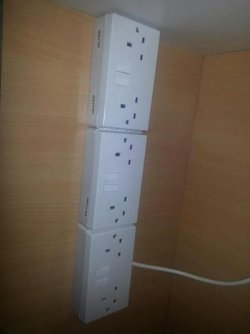so after a long tiring time of running, my main living room display tank is now going under a renovation whilst I currently have it all in pieces and out the living room whilst we redecorated. The glass, filter & fish are staying with everything else being replaced although the hood will be last.
A new stand to house the filter is being built and I have decided to break away from the 'frame then clad' approach and instead going for a furniture board structure. I have based this on calculations of the weight of the new sand, water, ornaments and so forth and for the 40 gallon tank size, decided that this is adequate. It will also be supported by 6 adjustable cabinet feet. I managed to locate heavy duty ones rated to over 100KG each, so the spread load will be fine at around 40KG-50KG per foot. I have had to adopt this approach as I need around 25mm-30mm adjustment between the feet for a level surface due to the fact my floor was clearly done by someone with a ruler & level they got at a carnival or circus.
This is all going in oak coloured furniture board, with a black sand substrate. I will be replacing the existing Beech hood, but that may happen a while after the current changes. The plan is to steal the 'front flap' design on the hood that Zikofski used in his stand build as i liked solution a lot.
So fingers crossed these parts will be appearing before the weekend when we begin building
A new stand to house the filter is being built and I have decided to break away from the 'frame then clad' approach and instead going for a furniture board structure. I have based this on calculations of the weight of the new sand, water, ornaments and so forth and for the 40 gallon tank size, decided that this is adequate. It will also be supported by 6 adjustable cabinet feet. I managed to locate heavy duty ones rated to over 100KG each, so the spread load will be fine at around 40KG-50KG per foot. I have had to adopt this approach as I need around 25mm-30mm adjustment between the feet for a level surface due to the fact my floor was clearly done by someone with a ruler & level they got at a carnival or circus.
This is all going in oak coloured furniture board, with a black sand substrate. I will be replacing the existing Beech hood, but that may happen a while after the current changes. The plan is to steal the 'front flap' design on the hood that Zikofski used in his stand build as i liked solution a lot.
So fingers crossed these parts will be appearing before the weekend when we begin building







